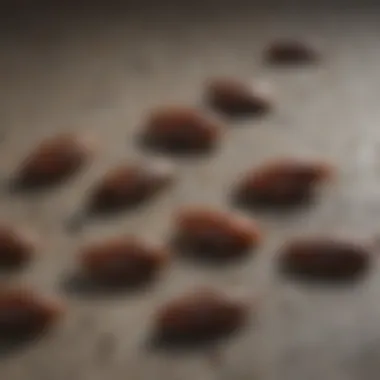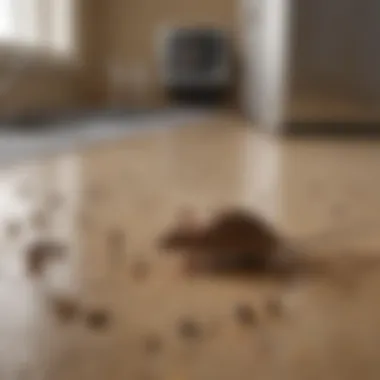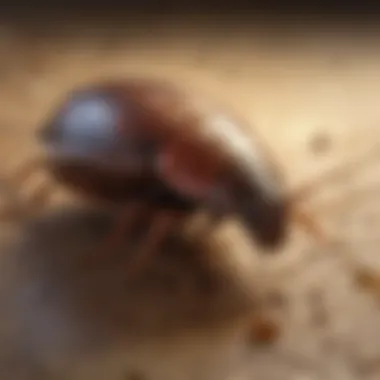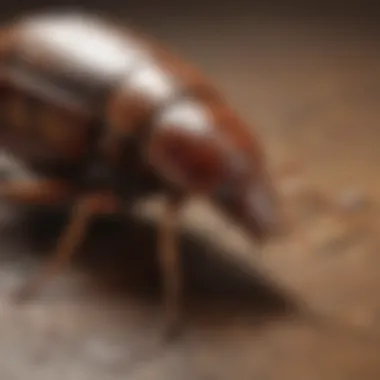Understanding Cockroach and Mouse Droppings: Health Risks


Intro
Understanding the presence of cockroach and mouse droppings in your home can reveal more than just a nuisance. These droppings are often the first signs of an underlying pest problem. Identifying them early can help prevent more serious health risks and infestations. This section will guide homeowners through recognizing these droppings and the implications of their presence.
Pest Identification
Identifying pests is a crucial step in managing infestations.
Common Household Pests
Cockroaches and mice are two of the most common household pests. Cockroaches are typically brown or black, depending on the species, with a flattened shape and long antennae. Mice are small rodents, usually around two to four inches in body length, with soft fur and pointed snouts. Both are known for their ability to reproduce quickly and adapt to their environments.
Understanding their habits is essential for effective pest control. Cockroaches thrive in warm environments and are common in kitchens and bathrooms. Mice often invade homes seeking food and shelter, frequenting basements and attics.
Signs of Infestation
Detecting the droppings from these pests is critical in identifying an infestation.
- Cockroach Droppings: These are dark brown or black, appearing as tiny pellets about 1-2 mm long. They are often found near food sources, such as cupboards or under appliances.
- Mouse Droppings: Usually, these are approximately 3-8 mm long with pointed ends, typically scattered around food areas or pathways.
Paying attention to these signs can enable prompt action.
Prevention Methods
Preventive measures can significantly reduce the chances of pest issues.
Environmental Modifications
Making changes to your home environment can deter pests:
- Seal Entry Points: Mice can squeeze through small gaps. Sealing them can prevent entry.
- Food Storage: Store food in airtight containers to reduce attraction.
- Moisture Control: Fix leaking pipes and reduce excess moisture. Cockroaches are attracted to damp areas.
Home Maintenance Tips
Keeping a clean and organized home is key:
- Regularly sweep and vacuum to eliminate crumbs.
- Maintain a clutter-free environment to reduce hiding spots for pests.
- Dispose of garbage regularly and use tight-fitting garbage bins.
DIY Pest Control Solutions
When infestations occur, DIY solutions can offer convenience and effectiveness.
Natural Remedies
Some natural ingredients can help deter pests:
- Boric Acid: Effective against cockroaches when applied in cracks and crevices.
- Peppermint Oil: Mice dislike the strong scent. A few drops in entry areas can help.
DIY Traps and Barriers
Homemade traps can effectively capture pests:
- Cockroach Traps: Place a mixture of baking soda and sugar in a shallow dish to attract and kill cockroaches.
- Mouse Traps: Use simple snap traps that can be baited with peanut butter to catch mice.
Overview of Cockroaches and Mice
Understanding cockroaches and mice is essential for maintaining a healthy living environment. These pests are not just a nuisance; they can pose significant health risks through their droppings. This section explores the biological characteristics and habitat preferences of these pests, providing insights into their behaviors and roles in our homes. Knowledge of these aspects is critical for effective pest management and protection against infestation.
Biological Characteristics


Cockroaches and mice exhibit distinct biological features that enable them to thrive in various environments.
Cockroaches are primarily nocturnal insects. They have flat bodies, long antennae, and can move quickly. There are several species, with the American cockroach and German cockroach being the most common in homes. Their bodies can withstand extreme conditions, which makes eradication difficult. They also reproduce rapidly, meaning infestations can escalate quickly if not addressed.
Mice, on the other hand, are small rodents characterized by their sharp teeth, long tails, and keen sense of smell. The most common species in households is the house mouse. Mice are known for their adaptability, which allows them to survive in various habitats while often entering human homes in search of food and shelter. Their reproductive cycle is similar to that of cockroaches, leading to population surges under favorable conditions.
Habitat Preferences
The habitat choices of cockroaches and mice are pivotal in determining their presence in homes.
Cockroaches prefer warm, dark, and moist environments, often finding refuge in kitchens, bathrooms, and basements. They tend to congregate in places where food and water are accessible. Cracks and crevices in walls provide ideal hiding spots for these pests, making it crucial to seal potential entry points.
Mice prefer habitats that are close to food sources. They are often found in kitchens and storage areas but can also create nests in attics or behind walls. Mice can squeeze through small openings, as they have flexible bodies. Understanding these habitat preferences can aid in controlling and preventing infestations.
Equipping homeowners with this understanding is vital, as early detection and effective strategies can significantly reduce health risks associated with these pests.
Significance of Droppings
Understanding the significance of droppings from cockroaches and mice goes beyond mere identification. These droppings serve as vital indicators for assessing the urgency of pest situations in homes. Recognizing and interpreting droppings can provide immediate insights into the extent of an infestation and the type of pest present. Each droppings type carries with it implications that homeowners need to comprehend for effective management.
Identification of Infestation
Identifying droppings is the first important step in recognizing an infestation. Cockroach droppings are typically small, dark, and resemble coffee grounds or tiny black specks. In contrast, mouse droppings are generally larger, about the size of a grain of rice, with pointed ends. By knowing these characteristics, homeowners can swiftly assess if an infestation exists.
The size, shape, and quantity of droppings often relate directly to the severity of the problem. A small number of droppings may indicate that pests are not permanently established, while large clusters may suggest an extensive infestation. Prompt recognition can lead to quicker intervention, minimizing potential health risks.
Some key points to consider:
- Location matters: Finding droppings near food sources or nesting areas often signals a greater concern.
- Mixed droppings: Presence of both cockroach and mouse droppings can indicate multiple infestations.
- Habits of pests: Cockroaches leave droppings even when not seen, while mice regularly defecate as they travel.
"Regular inspections for pest droppings can protect your home against health risks and future infestations."
Understanding Pest Behavior
Understanding the behavior of pests, particularly through their droppings, informs control strategies. Cockroaches and mice are nocturnal creatures, often active when humans are not. Their droppings can be found in the corners or hidden areas where these creatures tend to hide, such as under sinks, behind appliances, or in storage areas.
Each pest’s nature is uniquely linked to its droppings. For example, when mice are foraging for food, they leave droppings frequently along their paths. This behavior indicates not just presence but also feeding activities, calling for immediate action from homeowners to deter them. In contrast, cockroaches tend to spread their droppings across a larger area, signifying a more widespread presence.
This understanding allows homeowners to:
- Establish targeted cleaning and treatment plans.
- Determine if the situation is worsening and take action accordingly.
- Recognize factors that may lead to more infestations, such as undetected food sources or shelter locations.
Through this knowledge, one can effectively design proactive methods to maintain a pest-free environment in their homes.
Cockroach Droppings
Cockroach droppings serve as a crucial indicator of infestation in residential and commercial properties. Understanding the implications of these droppings can provide insights into the level of infestation and the necessary steps for effective management. Homeowners need to recognize the signs of a cockroach presence to take preventive action.
Appearance and Characteristics
Cockroach droppings are often small, dark, and cylindrical. Their size typically ranges from 1 to 5 mm in length, varying slightly based on the cockroach species. American cockroaches, for example, produce larger droppings compared to German cockroaches. The appearance can be likened to coffee grounds or black pepper. Notably, these droppings are a mix of digested food and waste, leading to an unsightly and unsanitary condition if not addressed.
Key Point: Recognizing the physical characteristics of cockroach droppings can hasten identification of an infestation.
In addition to size, the quantity of droppings can indicate the severity of the problem. A small number may suggest a few roaches, while a large accumulation indicates a more established population. Droppings will often be found clustered in areas where roaches frequent, such as in kitchens or behind appliances. Regular inspection in these zones is essential.
Health Risks Associated
Cockroaches are vectors for various pathogens, making their droppings a significant health concern. Exposure to these droppings can lead to various health issues, particularly for sensitive populations such as children, the elderly, and individuals with respiratory conditions. The droppings can contain allergens and harmful bacteria that may contribute to allergic reactions and asthma attacks.
Health concerns linked to cockroach droppings include:


- Allergies: Particulates from droppings can trigger allergic reactions, resulting in symptoms such as sneezing, runny nose, and itchy eyes.
- Asthma: Studies have shown a strong correlation between cockroach droppings and the exacerbation of asthma symptoms.
- Food Contamination: If droppings come into contact with food, they pose a risk of foodborne illnesses, including gastroenteritis and salmonella.
Because of these health risks, it is vital for homeowners to act swiftly upon noticing signs of cockroach presence. Implementing effective sanitation practices and engaging pest control professionals can significantly mitigate health risks associated with cockroach droppings.
Mouse Droppings
Mouse droppings are critical indicators of infestation. Their presence often signifies that a home or building is not just visited but potentially inhabiting by mice. Understanding the characteristics of mouse droppings is vital for homeowners to take swift and effective action. Mouse droppings are not only a sign of rodent activity; they also pose serious health risks. Thus, knowing how to identify, assess, and manage these droppings can lead to safer living conditions.
Identification and Differences from Other Pests
Recognizing mouse droppings is essential for distinguishing them from other pest droppings. Mouse droppings are small, typically measuring about a quarter of an inch in length. They have a pointed end and are often dark brown or black in color. Unlike rat droppings, which are larger and have a more blunt end, mouse droppings tend to be more cylindrical.
Here are key characteristics to help identify mouse droppings:
- Shape: Cylindrical with pointed ends.
- Size: Approximately ¼ inch in length.
- Color: Typically dark brown or black, glossy appearance.
In contrast, droppings from pests like cockroaches are distinctly different in size and shape, often being flat and oval. Identifying the type of droppings is crucial for choosing the appropriate control methods.
Health Risks and Diseases
Mouse droppings carry various health risks. They are known to transmit diseases, some of which can be severe. The droppings contain allergens which may cause allergic reactions, particularly in sensitive individuals. Moreover, mice can carry hantavirus, which can lead to serious respiratory conditions.
Here are some diseases associated with mouse droppings:
- Hantavirus Pulmonary Syndrome: This severe respiratory disease can be contracted through inhalation of particles from mouse droppings.
- Salmonellosis: Food contamination from mouse droppings can lead to gastrointestinal illness.
- Lymphocytic Choriomeningitis (LCMV): A viral infection that can cause neurological symptoms.
The health implications of mouse droppings underline the importance of timely identification and action. By understanding the implications associated with mouse droppings, homeowners can better protect their families and maintain a healthier living environment.
To summarize, mouse droppings are a clear signal of presence and potential issues related to health and safety. The ability to identify them correctly and act upon that knowledge can prevent further infestation and health complications.
Methods for Detecting Infestations
Detecting infestations early is crucial for effective pest management. The presence of cockroach and mouse droppings can be a clear indication of their activity. Understanding how to identify and analyze these droppings can prevent larger problems. The methods discussed can assist homeowners in recognizing infestations promptly, protecting both health and property.
Visual Inspection Techniques
Regular visual inspections play a key role in pest detection. Homeowners should focus on areas prone to infestation, including kitchens, basements, and garages.
Important aspects of visual inspections include:
- Observe Droppings: Look for droppings. Cockroach droppings are small, dark, and cylindrical. Mouse droppings are shaped like grains of rice. Notice the quantity; larger amounts suggest a significant presence of pests.
- Check for Other Signs: Besides droppings, inspect for urine stains, nesting materials, and gnaw marks, as these can also indicate activity.
- Timing of Inspection: Conduct inspections during the night since many pests are more active in low light. This can provide a clearer view of their movements.
- Create a Checklist: Document areas inspected and findings for future reference. Keeping a record can help identify trends in pest activity over time.
Regular visual inspection allows for early detection of infestations. Implementing this practice can greatly reduce immediate risks, making it an essential tool in pest management.
Using Traps and Monitoring Tools
Using traps and monitoring tools adds another layer to pest detection strategies. These tools help identify the presence of cockroaches and mice more effectively.
Here are key considerations when using traps and monitoring tools:
- Different Trap Types: There are sticky traps, snap traps, and bait stations. Sticky traps capture pests, allowing for easy monitoring of infestation levels. Snap traps quickly eliminate rodents, while bait stations lure and kill pests safely.
- Placement Matters: Position traps in areas where droppings have been observed or where activity is suspected. Corners, along walls, and near entry points are ideal locations.
- Regular Checks: Inspect traps frequently. This ensures that the traps remain effective and allow for timely action against pests.
- Monitoring Reports: Consider using electronic monitoring systems for larger properties. These systems can provide real-time data about pest activity, enabling faster response measures.
Keeping a close eye on traps helps determine the severity of an infestation, enabling informed decisions about necessary control measures.
Removal and Control Strategies
Removal and control of cockroach and mouse droppings are essential steps for effective pest management. Understanding the implications of these droppings offers insights into broader infestation issues and health risks. By implementing appropriate removal and control strategies, homeowners can significantly improve their living conditions and reduce exposure to harmful pathogens.
Sanitation Practices
Sanitation is the foundational aspect of controlling cockroaches and mice in residential settings. A clean environment deters these pests, as they thrive in clutter and filth. Regular cleaning and maintenance practices can greatly minimize droppings and the likelihood of infestations.


- Routine Cleaning: Vacuuming regularly, especially in corners and under appliances, can help remove droppings and potential food sources.
- Food Storage: Store food in sealed containers to prevent access and eliminate attractants. This reduces the chances that pests will find a reliable food source in your home.
- Waste Management: Dispose of garbage promptly and consider using covered trash bins. Keeping waste sealed limits the access mice and cockroaches have to suitable breeding grounds.
Implementing these sanitation practices not only reduces droppings but also contributes to a healthier living environment. By maintaining cleanliness, the chances of re-infestation decrease, creating a fewer hospitable habitat for pests.
Mechanical and Chemical Control Options
When sanitation alone is insufficient, additional control measures must be considered. Both mechanical and chemical solutions can effectively target and eliminate pest populations.
- Mechanical Options: Traps are an effective way to control pest populations. Snap traps for mice and sticky traps for cockroaches work well to capture these pests without the use of chemicals. Place traps in high-traffic areas for maximum results.
- Chemical Options: Insecticides and rodenticides can effectively manage infestations. Always follow safety guidelines and consider environmentally friendly products when possible. When using chemicals, it is important to:
- Apply according to the manufacturer's instructions.
- Ensure that pets or children are not exposed to these substances.
Ultimately, combining sanitation practices with mechanical and chemical control options results in a more comprehensive pest management strategy. Regular assessment of the environment and prompt action can alleviate the risks associated with cockroach and mouse droppings, contributing to a healthier home.
Preventive Measures
Preventive measures play a crucial role in managing cockroach and mouse droppings. Ensuring that these pests are kept at bay not only minimizes their presence but also greatly reduces the health risks associated with their droppings. By implementing effective preventive strategies, homeowners can create a less inviting environment for these pests, avoiding costly infestations and maintaining a healthier living space.
Seal Entry Points
One of the most effective strategies to prevent pest infestations is sealing potential entry points in and around the home. Cockroaches and mice can squeeze through surprisingly small gaps. Therefore, it is essential to thoroughly inspect the property for openings where pests might enter.
Begin with the following steps:
- Inspect Walls and Foundations: Check for cracks and gaps in walls, foundations, and around windows and doors. Use caulk or spray foam insulation to seal these spaces.
- Examine Utility Lines: Look closely where pipes or wires enter your home. Gaps around utility lines can be sealed using mesh or other suitable materials.
- Install Door Sweeps: Ensure that all exterior doors have weather stripping and door sweeps to block potential access.
By securing these points, the likelihood of pests entering the home is significantly decreased, making it a critical consideration for every homeowner.
Regular Maintenance Practices
Maintaining a clean and organized living environment is equally important in pest prevention. Consistent maintenance practices create an inhospitable atmosphere for cockroaches and mice.
Consider adopting these practices:
- Daily Cleaning Routines: Ensure that food scraps are cleaned up promptly and that dishes are washed regularly. Sweep and mop floors to remove crumbs and spills that attract pests.
- Proper Food Storage: Store food in airtight containers. This not only preserves freshness but also prevents pests from accessing tempting food sources.
- Declutter: Reduce clutter in your home. Cardboard boxes and piles of paper can provide nesting materials for pests. Keep areas such as attics and basements organized and clear.
- Regular Inspections: Perform routine checks of your home for any signs of pests or droppings. Catching an infestation early can help prevent larger problems later.
By integrating these regular maintenance practices into your lifestyle, you create an environment that deters pests from making your home their own.
"An ounce of prevention is worth a pound of cure."
Environmental Considerations
Understanding the environmental implications of cockroach and mouse droppings is crucial for effective pest management. Different pest control methods can significantly influence local ecosystems. This section explores both the impacts of pest control on ecosystems and introduces sustainable pest management solutions. Employing these approaches minimizes harm while effectively addressing pest problems.
Impact of Pest Control on Ecosystems
When dealing with pest infestations, it is key to consider how control measures affect surrounding ecosystems. Chemical pesticide use, for instance, can lead to unintended consequences. Beneficial insects such as bees and ladybugs may also suffer from exposure to these chemicals. Over time, this loss of biodiversity can disrupt food chains, affecting not just pests but also their natural predators.
Moreover, the use of some rodenticides can lead to secondary poisoning of wildlife. Birds of prey and other mammals may ingest poisons when they consume affected rodents. This chain reaction can have severe implications for wildlife populations and overall ecosystem health.
Important Note: Always consider the broader impact of pest control methods on local wildlife and ecosystems before implementation.
Sustainable Pest Management Solutions
Sustainable pest management focuses on long-term strategies that balance effectiveness with minimal environmental harm. Here are some key practices:
- Integrated Pest Management (IPM): This strategy combines various control techniques. It includes monitoring pest populations, applying biological controls, and using pesticides only when absolutely necessary. This method reduces reliance on harmful chemicals.
- Natural Predators: Encouraging natural predators can significantly lower pest numbers. For example, encouraging birds that feed on insects can help control cockroach and mouse populations without the need for harmful treatments.
- Habitat Modification: Making environmental changes can reduce pest attraction. This involves eliminating standing water, trimming back foliage, and sealing cracks to limit hiding spaces.
- Biological Controls: Introducing beneficial insects or microorganisms can help manage pests naturally. For instance, nematodes are effective against cockroach larvae and can be introduced in areas where infestations are noted.
- Education and Awareness: Informing homeowners about pest prevention strategies is a powerful tool. This knowledge equips them to take proactive measures, reducing the likelihood of infestations.
In essence, being conscientious about how pest control impacts the environment is vital. Opting for sustainable practices not only protects our health but also the ecosystems we inhabit.
Closure
The examination of cockroach and mouse droppings is crucial for effective pest management. These droppings are more than mere waste; they are significant indicators of infestation. Understanding their implications can assist homeowners in taking prompt action. This response is vital, as timely intervention can minimize health risks and property damage.
Summary of Findings
Through this article, we have highlighted the numerous aspects connected to cockroach and mouse droppings. First, we discussed their distinct characteristics and how these can aid in identification. We elucidated the health risks associated with every pest. The findings suggest high contamination potential from droppings. Further, we explored various methods for detection, emphasizing the necessity of regular inspections. Together with removal and control strategies, these elements create a holistic pest management approach. Understanding these details arms homeowners with the knowledge to skillfully manage infestations.















